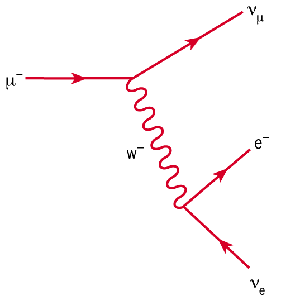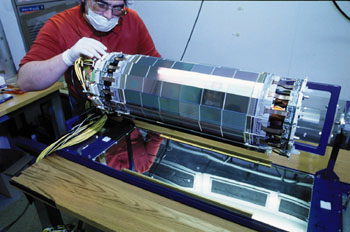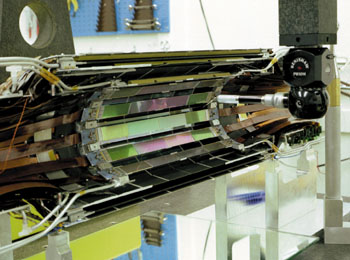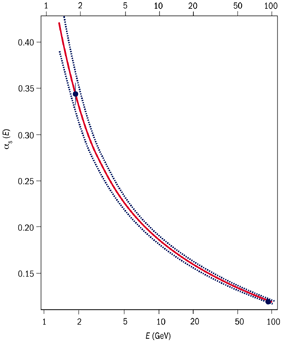A quarter of a century ago, Martin Perl discovered a new particle: the tau lepton. This weakly interacting particle is so heavy that it can decay into strongly interacting particles and provide very special physics conditions. It is described here by long-time tau specialist Antonio Pich.

In 1975 Martin Perl found a new exotic lepton in electron-positron collisions at the SPEAR ring at SLAC, Stanford. The electrically charged tau turned out to be a heavy brother of the muon and the electron. The tau is 170 times as heavy as the muon and 3500 times as heavy as the electron, and has roughly the properties to be expected for such a particle. Owing to its very short lifetime (2.9 x 10-12 s) and the presence of unseen particles (neutrinos) in its decays, the detailed investigation of the tau has been an experimental challenge ever since its discovery.

In the past few years, the four experiments at CERN’s LEP electron-positron collider have each produced a very clean sample of tau pairs (some 0.2 million) with low backgrounds. The very good particle identification of the LEP detectors and the use of modern silicon microvertex technologies have created a wonderful environment in which to investigate the tau.
At the same time, the CLEO II detector at Cornell’s CESR electron-positron ring has collected more than 10 million tau pairs, making it possible to study the rare tau decays. As a result, tau physics has reached a level where precise tests can be performed.
Lepton universality
The existence of different families is one of the most important open questions in particle physics. The basic matter structure of the Standard Electroweak Theory with the up and down quarks (the electron and the electron neutrino) appears to have two heavier replicas with identical interactions: the charm and strange quarks with the muon and the muon neutrino; and the top and bottom quarks with the tau lepton and its neutrino.
We do not understand what causes this triplicity, nor do we know what generates the different masses. However, we expect the heavier family to be more sensitive to whatever dynamics are related to the generation of mass. This makes the tau an ideal particle to use to investigate these gaps in our understanding. Is the tau really identical to the electron and the muon?
In the Standard Model, the tau decays in the same way as the muon: through emission of a W boson (shown in figures 1 and 2). However, the tau’s heaviness makes several extra decay modes kinematically accessible. The tau can either decay leptonically into its lighter electron and muon brothers, accompanied by appropriate neutrinos, or it can decay into quarks. Because quarks can appear in three different “colours”, the probability of a hadronic decay is three times greater than leptonic decay. The detailed analysis of the tau decays shows an excellent agreement between the measured branching fractions and the Standard Model predictions.
Comparing the different tau decays with the weak decays of the muon and the charged pion, we can test whether the different leptons couple to the W with the same strength. Within the present (and impressive) experimental accuracy of 0.2%, the electron, the muon and the tau appear to have exactly the same W interactions. The same observation can be made directly from the analysis of W decays at LEP II and the proton-antiproton colliders, although, the present experimental sensitivity is not as good in this case.
The leptonic couplings to the neutral Z particle have been accurately measured at LEP and SLC (SLAC, Stanford), through the study of lepton-antilepton production in electron-positron collisions. Again, the experimental data show that the three known leptons have identical interactions with the Z boson, at the present level of experimental sensitivity.
Because the tau decays within the detector – a tau produced at LEP travels 2.2 mm before decaying (a tau produced at CLEO travels 0.24 mm) – one can measure its spin orientation (polarization) from the distribution of the final decay products. The present data show that only left-handed taus decay. This is in good agreement with the Standard Model. An upper limit of 3% has been set on the probability of a (disallowed) decay from a right-handed tau.

A lepton with strong interactions
Leptons do not couple to the gluonic carriers of the strong interaction. However, an electroweak boson emitted by a lepton can produce quarks, which are strong interacting particles. Electrons and muons only feel this effect indirectly, through tiny quantum corrections. The heavier tau can decay hadronically, which makes the tau a unique tool for studying strong interaction dynamics in a clean way.

Between 1988 and 1992, a series of papers by Eric Braaten, Stephan Narison and the author showed that the hadronic decay of the tau can be theoretically predicted from first principles, as a function of the quantum chromodynamics (QCD) coupling as Summing over all possible hadrons produced in the decay, avoids the problems related to the messy rearrangement of quarks into hadrons. The decay probability can then be computed at a more fundamental level in terms of quarks and gluons. The result is known up to the third order in a perturbative expansion in powers of as. Comparison of the theoretical predictions with the experimental measurements gives a precise determination of as at the tau mass region.
An extensive experimental effort was initiated in 1992 by an ALEPH group at LEP, which was led by Michel Davier at Orsay. This was soon followed by similar work from other experiments. The four LEP collaborations and CLEO have all performed their own measurements of as. Moreover, ALEPH and OPAL, through a careful analysis of the distribution of the final decay hadrons, have been able to measure, separately, the tiny non-perturbative corrections and obtain values in good agreement with theoretical expectations.
The resulting determination, as (mt) = 0.345 ± 0.020, shows that the coupling, measured at the tau mass scale, is very different from the values obtained at higher energies. The value extracted from the hadronic decays of the Z boson, 0.119 ± 0.003, differs from the tau decay measurement by eleven standard deviations.
The comparison of these two measurements is of fundamental importance within our present understanding of quantum field theory. Quantum corrections, mainly generated through the virtual production of particle-antiparticle pairs, modify the values of the bare couplings in a way that depends on the energy scale. This is a very important effect, which, in the context of non-abelian gauge field theories (like the electroweak theory or QCD), is deeply related to the 1999 Nobel prizewinning work by ‘t Hooft and Veltman.
Gross, Politzer and Wilczek showed that in non-abelian theories quantum effects give rise to “asymptotic freedom”, in which the coupling decreases as the energy increases. Asymptotic freedom explains why high-energy experiments feel quarks as nearly free particles, while at low energies they are strongly confined within hadrons. The tau provides the lowest-energy scale where a very clean measurement of the strong coupling can be performed, which gives an opportunity to test asymptotic freedom in a quantitative way. Using the theoretically predicted dependence of as on energy, the measurement of as at the tau mass can be translated into a prediction of as at the Z mass scale: 0.1208 ± 0.0025. This value is in close agreement with the direct measurement from hadronic Z decays, and has a similar accuracy.
Tau decays, which result in an even number of pions, have also been used to measure the hadronic vacuum polarization effects that are associated with the photon. It is possible, therefore, to estimate how the electromagnetic fine structure constant is modified at LEP energies. The uncertainty of this parameter is one of the main limitations on the extraction of the Higgs mass from LEP/SLD data. From the ALEPH data, the Orsay group is able to reduce the error of the fitted log(MH) value by 30%.
The same tau data can pin down the hadronic contribution to the anomalous magnetic moment of the muon. Recent ALEPH and CLEO analyses have improved the theoretical prediction by setting a reference value to be compared with the forthcoming measurement of the E821 experiment, which is running at Brookhaven.

Weighing the strange quark
About 3% of tau decays produce a strange quark. The four LEP experiments have investigated these decays. In particular, ALEPH has analysed kaon production in tau decay and the associated distribution of the final hadrons. The difference between the dominant decay producing a down quark, and that producing a strange quark is sensitive to the mass difference between the down and strange quarks. Because the former is much lighter, the ALEPH measurement can be translated into a good determination of the strange quark mass at the tau mass scale: 119 ± 24 MeV.
Quark masses are also dependent on energy; quarks weigh less at higher energies (and weigh more at lower energies). At 1 GeV, for instance, the strange quark mass becomes 164 ± 33 MeV. These measurements have important implications for the theoretical prediction of CP violation in kaon physics. Future tau analyses at the BaBar and BELLE detectors should provide a more accurate determination of the strange quark mass.
Tau decay data has been probed extensively for signatures of new physics beyond the Standard Model framework. Using its huge data sample, CLEO has looked for 40 forbidden tau decay modes. No positive signal has been found, which puts stringent upper limits (of a few parts per million) on the probability of many decays into final states without neutrinos. Anomalous electric and magnetic electroweak dipole couplings of the tau and possible CP-violating decay amplitudes have also been searched for, with negative results. Within the present experimental accuracy, the tau appears to be a standard lepton.
Tau decays are accompanied by neutrinos, so kinematical analysis of hadronic tau decays gives an upper limit on the tau neutrino mass: 18.2 MeV. However, nobody has been able to detect a tau neutrino so far. The DONUT experiment at Fermilab is expected soon to provide the first experimental evidence of the tau neutrino through the detection of its interaction with a nucleon via the produced tau.
This is an important goal in view of the recent neutrino results, which suggest tau-muon neutrino oscillations, and neutrino mass squared differences of around 0.003 eV2. These results could be checked by the new-generation long baseline neutrino experiments.
In 25 years we have seen remarkable progress in our knowledge of the tau and its neutrino. However, there is still much room for improvement, and, no doubt, the tau will continue to play an important role in the continuing search for new physics.







